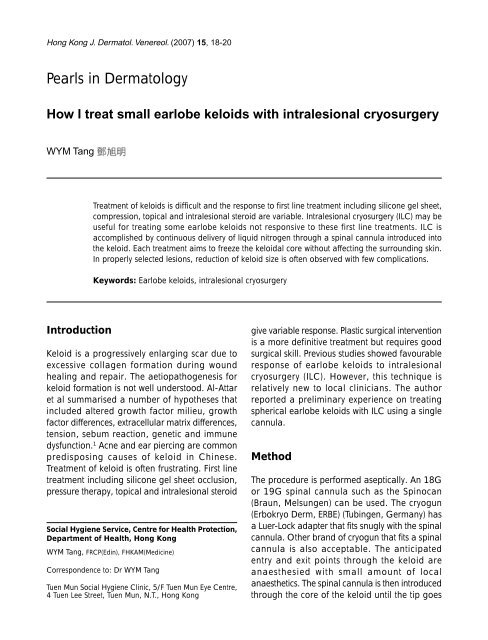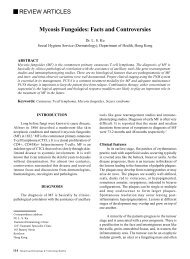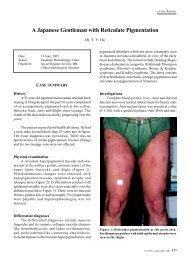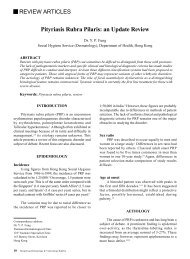How I treat small earlobe keloids with intralesional cryosurgery
How I treat small earlobe keloids with intralesional cryosurgery
How I treat small earlobe keloids with intralesional cryosurgery
You also want an ePaper? Increase the reach of your titles
YUMPU automatically turns print PDFs into web optimized ePapers that Google loves.
Hong Kong J. Dermatol. Venereol. (2007) 15, 18-20<br />
Pearls in Dermatology<br />
<strong>How</strong> I <strong>treat</strong> <strong>small</strong> <strong>earlobe</strong> <strong>keloids</strong> <strong>with</strong> <strong>intralesional</strong> <strong>cryosurgery</strong><br />
WYM Tang<br />
Introduction<br />
Treatment of <strong>keloids</strong> is difficult and the response to first line <strong>treat</strong>ment including silicone gel sheet,<br />
compression, topical and <strong>intralesional</strong> steroid are variable. Intralesional <strong>cryosurgery</strong> (ILC) may be<br />
useful for <strong>treat</strong>ing some <strong>earlobe</strong> <strong>keloids</strong> not responsive to these first line <strong>treat</strong>ments. ILC is<br />
accomplished by continuous delivery of liquid nitrogen through a spinal cannula introduced into<br />
the keloid. Each <strong>treat</strong>ment aims to freeze the keloidal core <strong>with</strong>out affecting the surrounding skin.<br />
In properly selected lesions, reduction of keloid size is often observed <strong>with</strong> few complications.<br />
Keywords: Earlobe <strong>keloids</strong>, <strong>intralesional</strong> <strong>cryosurgery</strong><br />
Keloid is a progressively enlarging scar due to<br />
excessive collagen formation during wound<br />
healing and repair. The aetiopathogenesis for<br />
keloid formation is not well understood. Al-Attar<br />
et al summarised a number of hypotheses that<br />
included altered growth factor milieu, growth<br />
factor differences, extracellular matrix differences,<br />
tension, sebum reaction, genetic and immune<br />
dysfunction. 1 Acne and ear piercing are common<br />
predisposing causes of keloid in Chinese.<br />
Treatment of keloid is often frustrating. First line<br />
<strong>treat</strong>ment including silicone gel sheet occlusion,<br />
pressure therapy, topical and <strong>intralesional</strong> steroid<br />
Social Hygiene Service, Centre for Health Protection,<br />
Department of Health, Hong Kong<br />
WYM Tang, FRCP(Edin), FHKAM(Medicine)<br />
Correspondence to: Dr WYM Tang<br />
Tuen Mun Social Hygiene Clinic, 5/F Tuen Mun Eye Centre,<br />
4 Tuen Lee Street, Tuen Mun, N.T., Hong Kong<br />
give variable response. Plastic surgical intervention<br />
is a more definitive <strong>treat</strong>ment but requires good<br />
surgical skill. Previous studies showed favourable<br />
response of <strong>earlobe</strong> <strong>keloids</strong> to <strong>intralesional</strong><br />
<strong>cryosurgery</strong> (ILC). <strong>How</strong>ever, this technique is<br />
relatively new to local clinicians. The author<br />
reported a preliminary experience on <strong>treat</strong>ing<br />
spherical <strong>earlobe</strong> <strong>keloids</strong> <strong>with</strong> ILC using a single<br />
cannula.<br />
Method<br />
The procedure is performed aseptically. An 18G<br />
or 19G spinal cannula such as the Spinocan<br />
(Braun, Melsungen) can be used. The cryogun<br />
(Erbokryo Derm, ERBE) (Tubingen, Germany) has<br />
a Luer-Lock adapter that fits snugly <strong>with</strong> the spinal<br />
cannula. Other brand of cryogun that fits a spinal<br />
cannula is also acceptable. The anticipated<br />
entry and exit points through the keloid are<br />
anaesthesied <strong>with</strong> <strong>small</strong> amount of local<br />
anaesthetics. The spinal cannula is then introduced<br />
through the core of the keloid until the tip goes
eyond it. The stylet is then removed. The hub of<br />
the cannula is then connected to the cryogun outlet<br />
by screwing tight. The cryogun should be kept in<br />
an upright position <strong>with</strong>out much tilting. Now start<br />
to spray liquid nitrogen. The cannula would<br />
gradually coat <strong>with</strong> white flakes due to formation<br />
of ice. Further continuous spraying produces<br />
freezing of the keloid and eventually formation of<br />
an 'ice ball'. After keeping the freezing for some<br />
seconds, stop spraying liquid nitrogen and let the<br />
'ice ball' to thaw until the cannula can be loosened<br />
and be removed <strong>with</strong> ease. The overall single<br />
<strong>treat</strong>ment time for one keloid may take few<br />
minutes.<br />
Erythema, mild oozing and sometimes crusting<br />
may occur. Patient is discharged <strong>with</strong> mild<br />
analgesic and 1:2000 aqueous chlorhexidine for<br />
daily dressing if required. Follow-up assessment<br />
and further <strong>cryosurgery</strong> may be contemplated if<br />
appropriate.<br />
Figures 1 to 3 depict the procedure and clinical<br />
progress in a Chinese teenage girl <strong>with</strong> right<br />
postauricular keloid not responsive to <strong>intralesional</strong><br />
<strong>How</strong> I <strong>treat</strong> <strong>small</strong> <strong>earlobe</strong> <strong>keloids</strong> <strong>with</strong> ILC 19<br />
steroid injections. An 'ice ball' is created upon<br />
prolonged liquid nitrogen spray (Figure 1). Figure 2<br />
shows clinical progress at Week 0, Week 4, Week<br />
6 and Week 8. A total of two <strong>treat</strong>ments were<br />
given in Week 0 and Week 4. Figure 3 shows the<br />
changes in keloidal volume represented graphically.<br />
A continuing diminution of volume was noted and<br />
reached to 9 mm 3 at Week 24. To facilitate<br />
prolonged cryospraying, a nylon zip tie fastened<br />
around the cryogun and pressing tightly on the<br />
spray button ameliorates hand fatigue (Figure 4).<br />
Figure 1. Freezing of keloid to an 'ice ball'.<br />
Figure 2. Clinical progress.
20<br />
Figure 3. A graph to show reduction of keloid volume.<br />
Figure 4. Nylon zip tie pressing on spray button.<br />
Comments<br />
In <strong>cryosurgery</strong>, the extreme low temperature below<br />
freezing leads to cell death and tissue necrosis. It<br />
has a direct beneficial effect on the keloidal<br />
collagen, producing improved organisation of<br />
collagen bundles and parallelisation. 2<br />
WYM Tang<br />
The method of using <strong>intralesional</strong> <strong>cryosurgery</strong> for<br />
<strong>treat</strong>ing skin lesions is not new and was first<br />
reported by Weshahy. 3 A Medline search showed<br />
only a few open studies on ILC for <strong>treat</strong>ing <strong>keloids</strong>.<br />
One study on ten auricular <strong>keloids</strong> in nine<br />
Caucasians showed an improvement of pain and<br />
itch score. A mean percentage volume reduction<br />
of 67.4±23% was achieved after one cycle of<br />
liquid nitrogen <strong>treat</strong>ment evaluated six months<br />
afterwards. 4 The procedure is also well tolerated<br />
<strong>with</strong> mild pain or discomfort.<br />
Compared to ILC, the usual way to deliver liquid<br />
nitrogen via contact or spray method requires<br />
more <strong>treat</strong>ment sessions to achieve good results.<br />
Furthermore, epidermal melanocytes are more<br />
susceptible to the damaging effect of liquid<br />
nitrogen by direct <strong>cryosurgery</strong> and thus at risk of<br />
hypopigmentation.<br />
Preliminary experience suggested that ILC may<br />
be useful for some <strong>earlobe</strong> <strong>keloids</strong> which failed<br />
the usual first line <strong>treat</strong>ment methods. The author<br />
proposed a need for further evaluation of ILC on<br />
its <strong>treat</strong>ment efficacy and safety profile.<br />
References<br />
1. Al-Attar A, Mess S, Thomassen JM, Kauffman CL,<br />
Davison SP. Keloid pathogenesis and <strong>treat</strong>ment. Plast<br />
Reconstr Surg 2006;117:286-300.<br />
2. Har-Shai Y, Amar M, Sabo E. Intralesional cryotherapy<br />
for enhancing the involution of hypertrophic scars and<br />
<strong>keloids</strong>. Plast Reconstr Surg 2003;111:1841-52.<br />
3. Weshahy AH. Intralesional <strong>cryosurgery</strong>. A new technique<br />
using cryoneedles. J Dermatol Surg Oncol 1993;19:123-6.<br />
4. Har-Shai Y, Sabo E, Rohde E, Hyams M, Assaf C,<br />
Zouboulis CC. Intralesional <strong>cryosurgery</strong> enhances the<br />
involution of recalcitrant auricular <strong>keloids</strong>: a new clinical<br />
approach supported by experimental studies. Wound<br />
Repair Regen 2006;14:18-27.






